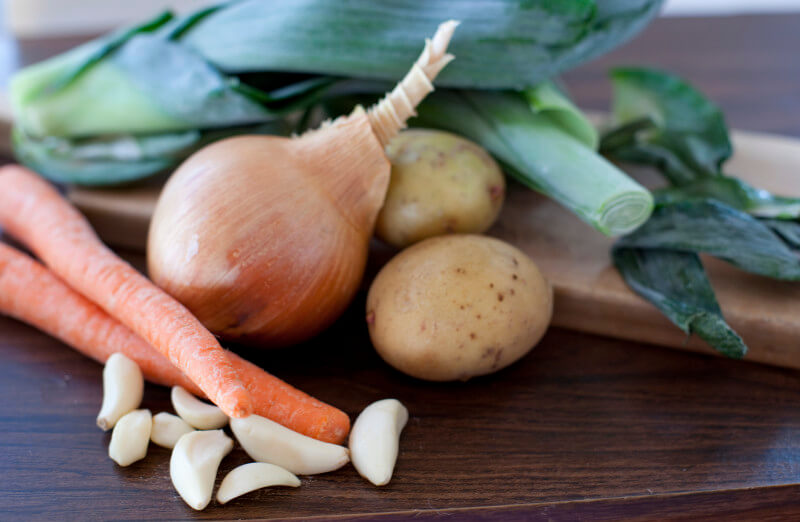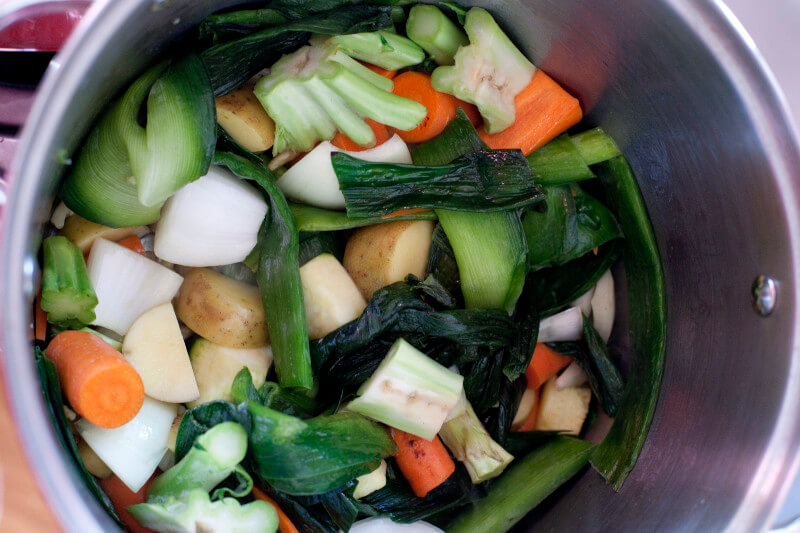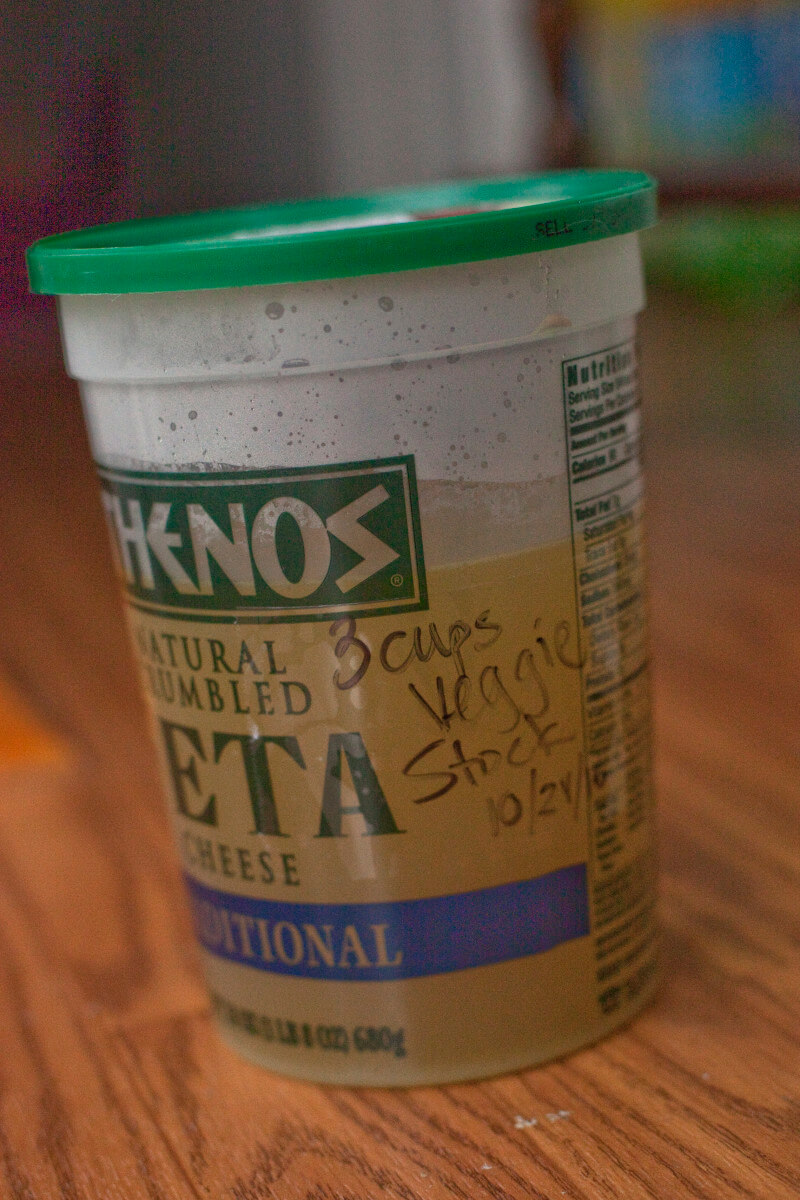
This homemade vegetable stock recipe just might blow your mind!
(Today’s post is an update from the archives, originally posted in October of 2010.)
When you’re on a tight budget, you’re always looking for ways to scrimp and save. One of the easiest ways to do this is by making your own soup stock. Not only is it more expensive to buy stock in the store, but it’s also full of sodium and preservatives that make it less healthy and add too much of a salty flavor.
You can save money by making your own homemade vegetable stock, but I have another secret for you to make this homemade vegetable stock recipe even more economical…

SAVE YOUR VEGGIE SCRAPS!
It seems so obvious once you start doing it.
I’ve got a few bags in my freezer full of leftover vegetable scraps. I put in broccoli stems, zucchini cores (from when I don’t want to use the seeds in a recipe) and stems, carrot peels, leek leaves, bell pepper cores, whatever bits of vegetables are clean and in good shape but wouldn’t normally get eaten. Once in a while if I know a vegetable might go bad before I can use it, like I’m getting too many vegetables from the CSA or my garden is overproducing, I toss it in the freezer bag too.
Our country wastes thousands of tons of food each year, and this is one of the many ways we try not to contribute to that waste, and save a little money too.
MAKE VEGETABLE STOCK FROM SCRATCH
Some of you may be wondering, “What is vegetable stock?” From what I understand (I’m no chef though!) stock is technically made with bones, so there is actually only vegetable broth, not stock. But the two terms (stock and broth) have become so interchangeable in the food industry that I’ve always heard it called stock, so I’m sticking with that!
Vegetable stock is the EASIEST stock to make. Although it takes about 40 minutes of cooking time, it’s only a few minutes of prep, especially if you chop your vegetables before putting them in the freezer.
In addition to the scraps I simply add a couple of carrots and potatoes, an onion (I don’t usually have any in my freezer bag), some smashed garlic cloves, fresh thyme and parsley, bay leaves, salt and pepper.

Speaking of salt, you can totally use more than my recipe calls for. I like to keep the flavor less salty because then I have more control over the saltiness when I use it in a future recipe. Basically I want my stock to taste lightly of vegetables, not a salt lick!
EASY HOMEMADE VEGETABLE STOCK RECIPE
Some people simply cover their vegetables with water and boil them immediately. I prefer to start by cooking them in a tablespoon of olive oil because I think a little caramelization is important for the flavor of the stock.
It’s not really precooking the vegetables, I just heat the oil in the pot and then start stirring the vegetables around to coat them in the oil and let them get a little golden in spots.
I also like having a hint of olive oil in the stock. If I’m making chicken or beef stock, they have fats from the animal, but that doesn’t happen naturally with vegetables.

Although I start out with 10 cups of water, I end up with about 8 cups of stock because of evaporation. You could keep the lid on to get a greater yield, but I think having it cook down some intensifies the flavor. I’ve tried it both ways and prefer it without a lid.
Once your stock is done you want to strain all the solids out (Eric calls this vegetable mush). I use a mesh strainer and if I really want a clearer stock strain it a second time through a coffee filter or paper towel.
Make sure to store the stock in containers labeled with the amount. You can stick it in the freezer and then know exactly how many containers to defrost for your recipe instead of having to defrost a large batch you’ll only use half of.
This week we’ll be using some of this stock to make butternut squash soup in the Healthy Cooking on a Tight Budget Program. What do you use vegetable stock for? Have you ever made your own?

KITCHEN TOOLS (thanks for supporting this site!):
Homemade Vegetable Stock Recipe

Save veggie scraps in your freezer and use them to make this flavorful, money saving vegetable stock.
Ingredients
- 2 carrots, washed
- 1 onion, peeled
- 2 potatoes, washed
- Greens from 2 leeks, can be frozen
- 2-4 cups of various vegetable scraps, can be frozen
- 1 TBS olive oil
- 8 cloves of garlic, smashed
- 4 sprigs of thyme
- 4 sprigs of parsley
- 2 leaves bay
- 1 tsp kosher salt
- 1 tsp whole peppercorns, I used combination of white and black
- 10 cups of water
Instructions
- Make sure all of your vegetables are clean and cut into chunks no bigger than 2 inches in diameter.
- Heat the olive oil in a large pot on high.
- When the oil begins to shimmer, add garlic, herbs, and seasonings.
- Immediately add all the vegetables and stir to distribute oil.
- Stir every 30 seconds for about 5 minutes until some caramelization has formed on the vegetables.
- Add the water, making sure it's enough to cover the vegetables (if not add a little more).
- Bring to a boil then reduce to a simmer for 30 minutes, uncovered.
- Pour stock through a strainer, discarding the vegetable mush.
- If a clearer stock is desired, strain again through a coffee filter or paper towel.
- Store in labeled plastic containers or bags in 2-3 cup amounts in your freezer.
Notes
Approximate cost/serving: I'm not even counting the veggie scraps, because they're things people normally throw away anyway. The total cost is under $2 for 8 cups!!! Imagine how much you can save using the homemade vegetable stock instead of canned stock!
Vegetarian/Gluten Free: Yes and vegan too!


When I first saw this post, I thought making your own stock is not always cheaper (though it is ALWAYS better) but then I saw that you also save vegetable scraps. That, for me, does make it cheaper and the elusive “worth it”. My first few times making vegetable stock I used all veggies I had bought from the store and felt like I spent a lot of time and money for what I got in return.
Then I started saving vegetable scraps as you do in plastic bags in the freezer, and felt like there was a true reward and economy there. I also use carrot peels, broccoli stems, and most of the other scraps you mention. I also save onion skin (except for the very outer layer) and the stems of leafy herbs as they give a great depth of flavor to the stock. Potato peelings are also great. Then when it comes time to make stock I put in a few fresh vegetables, depending on what my scrap bags lack, but always onions.
Great post!
I was just wondering if I could make this last night. YEA!! Thanks for sharing your recipe & ideas.
One good addition to vegetable stock is to add a few pieces of nori, which adds more depth of flavor. (Although it doesn’t fall in the ‘leftover’ category!)
Rachelino, I’m so glad I’m not alone in my scrap saving! Some people laugh at me but it totally saves money and makes great stock.
Alissa you’ll have to let me know how it turns out when you try it.
Ooh great idea David, I always have nori in the house so it wouldn’t really be much of an extra expense!
I love the idea of making this from scraps because I agree with Rachelino that if you are buying veggies expressly for this purpose it does taste better but isn’t always cheaper. I personally love roasing mine before making stock. I saw that in a Mark Bittman book once and think it’s genius! It really bumps up the flavor. I also love the idea of adding nori. I can definitely see where that would bring flavor and depth.
We made vegetable stock for the very first time a few days ago. Instead of using new vegetables, we had been saving scraps and trimmings for a couple of weeks. We were shocked at how fast those scraps collected – I never realized I threw away so much!
We also froze a few vegetables that had been in the bottom of the fridge bin for a little too long — we weren’t going to get to them in time before they went bad… So into the ziploc in the freezer they went!
We ended up making a little more than a gallon of stock, and freezing it in 1-quart containers for later use. It’s delicious — and considering that it was made entirely from vegetables that would have otherwise ended up in the trash, our cost-per-serving is effectively zero!
I love this idea! I never knew you could make stock from vegtables! I hate throwing away all those veggie scraps and I was wondering if there was something I could use them for! Thanks!
Could one puree the vegetable mush (instead of discarding it) and add it to homemade pasta sauce? Maybe not all at once, mind you, but some in each batch?
Cindy you could puree the vegetable mush if you were looking to use it as a thickener maybe for your sauce or soups, but most of the nutritional value has been cooked out of the vegetables and is now in the stock so it wouldn’t be a good idea to do it for nutritional purposes. Hope that helps!
If you have a compost pile, you could add the vegetable mush to it.
I was just thinking of making vegetable stock and stumbled on to your post on taste spotting. Caramelizing the veggies are an awesome idea. I need to start saving my veg scraps as well. I used to make chicken stock at home and use it for soups. I can use the veg stock for my minestrone. Thank you 🙂
Thanks for the recipe.
I use vegetable stock in several BEEF soup recipes I have, like fajita soup and beef caldo, both of which have a ton of fresh vegetables in them, and I don’t want beef broth wiping those out or weight them down. The whole point of them is to have a beautiful, fresh taste. Chicken stock/broth is all wrong with these beef recipes to me for some reason, so I started using vegetable–and got that restaurant taste and “lightness” that let the vegetables shine as much as the meat.
Since trying vegetable broth for my soups, I only use beef broth for things like caldo de res or pot roast, where the beef taste is what you’re wanting to emphasize.
Also, making my own vegetable stock means I can cut things I’m allergic to, like, oh, potatoes, and replace them with something my tummy can handle.
i thought the inside cores / pith / seeds of capsicum bell peppers were bitter wouldn’t this make the stock bitter??? Also some leaves and stalks of vegetables are poisonous, does anyone know which ones??? Basically I am asking what NOT to put into SCRAP vegetable stock???
Hi Jonathon, I have not had an issue with bell peppers making the stock bitter. As far as poisonous leaves/stalks, that’s more of an issue with fruits than vegetables. Make sure you don’t use rhubarb leaves or tomato leaves/stalks, but other than that there aren’t any typical vegetables you’d buy in the grocery store that you can’t use.
Here’s what I don’t understand about this process. Since most vegetables are supposed to be blanched before freezing, how are these scraps going to be good to make anything if they are kept in the freezer more than a few days?
Hi Leslie, the blanching of vegetables is primarily for preserving color and texture before freezing, although it does also help reduce nutrient loss as well. Since this is making stock and the vegetables will be strained out, we don’t worry about blanching them. We use them in soups with plenty of fresh veggies so don’t worry about lost nutrients either. But you could definitely steam your scraps to blanch them before freezing if you prefer.
This is one of those things that’s worth your time to make homemade. SO much more flavor and an ingredient list that you can trust.
Such a great stock recipe! I love making this when I’m cleaning out the fridge before grocery shopping! It works so great with a rotisserie chicken. So Yummy!